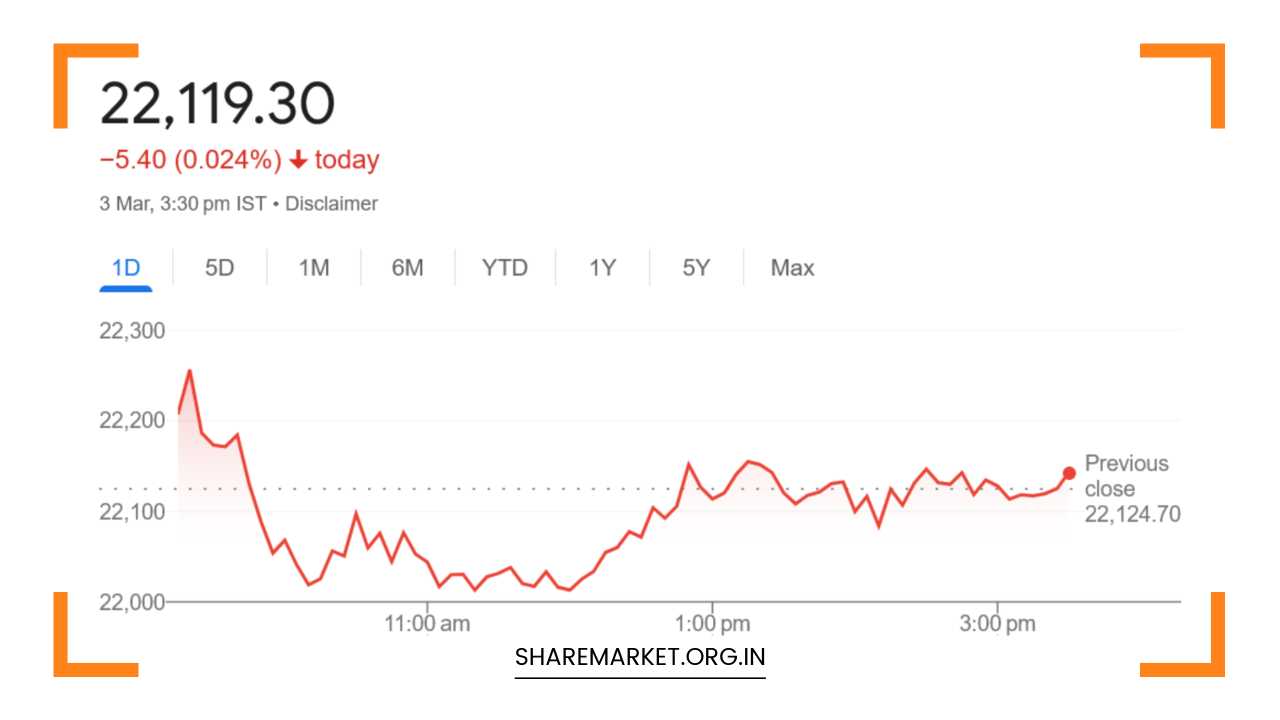Sensex Down 112 Points, Nifty at 22,119; Tomorrow Nifty Prediction

Tomorrow Nifty Prediction
Market Update: Nifty and Sensex Close Flat Amid Bearish Sentiment — What to Expect on March 4th
Market Overview: The Indian stock market closed relatively flat on March 3, reflecting a mixed trading session marked by volatility and uncertainty.
Both major indices, Sensex and Nifty, saw modest declines at the end of the day, continuing the trend of caution that has defined the broader market in recent weeks.
The bearish sentiment remains in play, leaving investors cautious about the market’s immediate future.
While the broader market may seem stagnant, the underlying trends point toward a potential for further downside unless key technical levels are breached in the coming sessions.
The Sensex ended the day at 73,085.94, down by 112.16 points or 0.15%. On the other hand, the Nifty closed marginally lower at 22,119.30, with a decrease of 5.40 points or 0.02%.
Despite these minor drops, the market breadth was notably negative, with 2,752 stocks declining, compared to 1,170 stocks advancing, indicating broader market weakness.
A mere 142 stocks remained unchanged, underscoring the lack of strong positive momentum.
This negative market action is in line with the ongoing bearish trend that has characterized much of the market since the beginning of 2025.
The flat closing reflects the market’s struggle to maintain a consistent upward trajectory in the face of a challenging macroeconomic environment and global uncertainties.
Sectoral Performance and Stock Highlights:
Within the stock market, specific sectors and stocks experienced varying degrees of volatility. Among the top gainers on the Nifty were Bharat Electronics, Eicher Motors, Grasim Industries, BPCL, and JSW Steel, all of which showed positive movement during the session.
These stocks helped mitigate the overall market decline, especially in the face of widespread selling across other sectors.
On the flip side, Coal India, Reliance Industries, Bajaj Finserv, HDFC Bank, and Bajaj Auto were among the top losers on the Nifty. These heavyweight stocks faced selling pressure, contributing to the overall downward bias in the market.
In terms of broader indices, the BSE Midcap index fell by 0.25%, while the Smallcap index posted a larger decline of 0.7%.
The divergence between large-cap stocks and mid-cap/small-cap stocks suggests that investors are favoring safer, large-cap names amid the prevailing market uncertainty.
Sectoral Outlook:
From a sectoral perspective, the market showed a mixed performance. Media, PSU banks, and oil and gas sectors all saw a decline of around 0.3% to 1%, reflecting the negative sentiment gripping these sectors.
These industries, which often rely on cyclical growth, are more vulnerable to economic slowdowns and the broader market pullback.
Conversely, consumer durables, IT, metal, and realty sectors showed resilience, with gains of 0.5% to 1%. These sectors have been performing relatively well in recent months, driven by a combination of domestic demand, resilient earnings, and global tailwinds in areas like IT and metals.
The realty sector, in particular, has benefited from improving demand in both residential and commercial real estate markets, further helping these stocks weather the broader market downturn.
Market Drivers and Expert Insights:
Several factors are driving the ongoing market volatility, with both domestic and international concerns weighing heavily on investor sentiment.
Foreign Institutional Investors (FIIs) have continued their pattern of net selling in Indian equities. According to market experts, this persistent selling pressure is a significant factor contributing to the bearish trend.
The absence of significant buying from FIIs has dampened market sentiment, leaving the market overly reliant on domestic investors, whose participation has not been enough to offset the selling.
Another major concern is the unpredictable political landscape in the United States, specifically related to the policies of Donald Trump.
Experts point to the fact that Trump’s policy changes often come without warning, creating a sense of uncertainty among global investors.
As a result, foreign capital flows into emerging markets like India have been hesitant, with investors fearing the adverse effects of geopolitical tensions or policy shifts.
Further compounding the issue is the sluggishness in corporate earnings. The third-quarter earnings for FY 2025 have been weaker than expected, with many companies reporting results below analyst estimates.
This earnings disappointment, which has been a recurring theme over the past two to three quarters, has added to the market’s ongoing decline.
A significant portion of Nifty companies has failed to meet earnings expectations, with less than 50% of firms delivering results in line with market projections.
This miss on earnings expectations has raised concerns about the broader health of the Indian economy and corporate profitability, adding to investor pessimism.
Technical Analysis and Expert Views:
Looking at the technical side of the market, Vatsal Bhuva of LKP Securities provided some insights into the Nifty’s technical setup. He observed that Nifty found support around the 22,000 level on Monday and managed to close above the critical 38.2% Fibonacci retracement level of 22,043.
The relative strength index (RSI) on the daily chart has entered the oversold zone, hovering near 22, which indicates that the index could be ripe for a short-term reversal.
A potential recovery in the near term could see Nifty targeting the 400-day Exponential Moving Average (EMA) at 22,475, which represents a level of resistance that traders will be watching closely.
However, despite this short-term potential for a bounce, Bhuva stressed that the broader trend remains bearish.
Until Nifty manages to break above the 22,600 mark on a closing basis, the market will likely continue to face downward pressure.
Immediate resistance for Nifty is seen at 22,300, while the support level is at 22,000. If this key support fails, the next level of support could be found at 21,800, a level that traders are watching closely for any further breakdowns.
Market Prediction for March 4th:
Looking ahead to March 4, the market faces a critical juncture. The ongoing bearish trend means that investors should remain cautious, particularly as we continue to see selling pressure from both domestic and foreign institutions.
Key levels to watch are 22,000 on the downside and 22,300 on the upside. A break below 22,000 could signal a continuation of the downward trend, potentially testing lower support levels at 21,800.
Conversely, a decisive close above 22,300 could indicate a short-term relief rally, though significant resistance at 22,600 could limit the market’s upside.
Given the current environment of weak earnings, global uncertainties, and domestic selling pressure, the market outlook for the near term remains uncertain.
Traders and investors should stay nimble and closely monitor these key technical levels and broader market cues as they look for signs of a potential reversal or continuation of the current trend.
In conclusion, while the market remains stuck in a bearish cycle, there are still potential short-term opportunities for those who are able to navigate the volatility carefully.

















